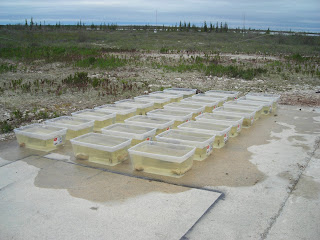I've always liked the idea of experiments. I'll admit I'm not always the most patient person out there but the idea of designing experiments to study phenomena has always appealed to me as a way of doing science. Also interesting is how salt has followed me around my scientific "career". Take my sixth grade science grade project. I entitled my project "The Great Saltwater Countdown" and while I tried to dig out an old picture of my poster board, I was unsuccessful, so my written description will have to do. Basically I chose 5 aquatic plants from the local pet store (3 of each for replication), put them in a large aquarium, added salt and recorded which ones perished and at which salt concentration. My thought was that global warming would cause large bodies of water to shrink, increasing their salt content and stressing the plants. I can't remember what my results were though...
...but 11 years later I am still adding salt to things. So in the spirit of scientific discussion, let me share one of the experiments I am setting up here in Churchill. From last year's field season I have an understanding of the resilience that zooplankton communities in a metacommunity system show towards manipulated salinity, most likely because of dispersal from nearby, non-manipulated areas. What I don't know much about is how the role of sediments, or more specifically resting structures within the sediments (the things zooplankton produce to overwinter or when conditions aren't favourable) influence this resilience. To test how easy it is for Daphnia ephippia to emerge under various salt conditons, I have set-up my own "mini bluff" just outside of the centre.


Like Da Bluff, this site is also frequented by Da Bunny (although I doubt it is the same one we spotted frequently last year).

Basically, I have extracted ephippia (see my previous post) from various habitats, cold shocked them and then rapidly dried and rehydrated them to induce emergence (simulating the passage of a winter season). Now I have put them into small microcosms under various salinity conditions and will monitor emergence. In addition to control microcosms there are three other aspects that I am testing.
1. I'm interested in knowing whether ephippia gathered from different environmental conditions (i.e. freshwater, brackish and salty habitats) will emerge at more or less the same time/ with the same success when placed under the same conditions (in this case freshwater). This is of interest because I have qualitatively observed differential timing of ephippia production between different environments.
2. Other studies (many based on Australian wetlands) have shown that periods of high salinity followed by low salinity (followed by high again) do not hinder ephippia emergence and in fact, disturbance sometimes causes increased emergence (the mechanism is still unknown). If I also find this pattern with my microcosms, this may explain why communities were able to still thrive under up and down regimes of salt addition last year.
3. While lab studies have tested the tolerance of adult stages of zooplankton to salinity levels, few have done any work on juvenile or resting stages. Therefore it is important to establish what the tolerance of these resting stages are.
Working with resting stages is pretty tricky. Even in lab conditions it can be difficult to induce hatching of ephippia and that doesn't factor in attempting to do this under almost natural conditions.
Anyways, this is the first of a series of experiments so we will see what happens (and whether my methods work!). I welcome comments and questions. On a final note, I'd again like to mention the wonderful Common Butterwort. Because they digest crawling insects, they don't need much of a root structure and therefore can grow in unusual places. These ones are growing almost upside down at the side of a pool.

Love it!!! Have fun with your microcosm experiment buddy!
ReplyDeleteSee you and your mini bluffs on Sunday!